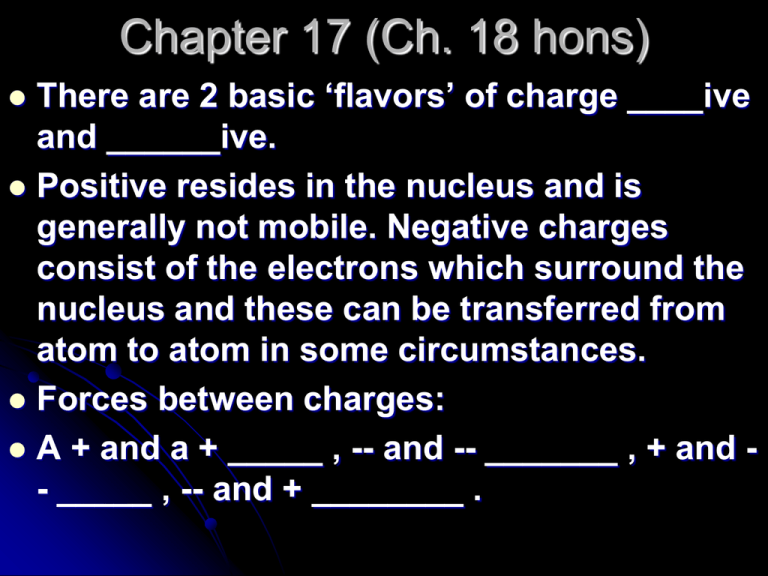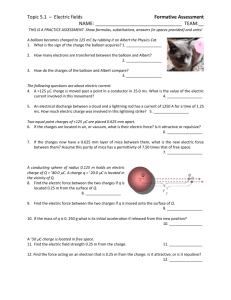Document
advertisement

Chapter 17 (Ch. 18 hons) There are 2 basic ‘flavors’ of charge ____ive and ______ive. Positive resides in the nucleus and is generally not mobile. Negative charges consist of the electrons which surround the nucleus and these can be transferred from atom to atom in some circumstances. Forces between charges: A + and a + _____ , -- and -- _______ , + and - _____ , -- and + ________ . Some things to know about charge… Charge is conserved – This comes from the idea that matter is conserved. Total amount of charge never changed. So if one object gains electrons becoming ______ive, the other loses exactly the same # of electrons becoming ______ive. Charge is quantized – (Millikan oil drop experiment) Charge only comes in very specific amounts – you can’t have ½ of an electron! Each electron has a charge of-1.6 X 10 -19 Coulombs (C). There are 3 types of materials as far as charge is concerned Insulators: Non-metals and most compounds Valence Electrons are basically bound to each atom and are not mobile Examples: Conductors: Metals, solutions of ionic compounds, molten ionic compounds. Valence electrons are loosely attached and can simply drift from atom to atom. Examples: Semiconductors Also known as the metalloids – they are along the stairs on the P.T.E. . Their electrons are loosely bound. They share properties of both conductors and _________ . Ex. Silicon, Germanium etc. Three ways to charge objects (describe with diags. On test) Contact: Works for insulators well. Induction: Works for conductors well. Polarization: Works for insulators. See board for explanation and diagrams of each. Your book also explains each way well. (P631-633) The physics classroom - from my website under static electricity Charging by contact Charging by induction Conductors Only!!!!! Charging by polarization No charge is Transferred !!!!! Insulators only. Homework P633. Q1 - 6 Hons. Page 566 1-6, 8. Van de Graff generator demos. Answer the questions in red on a separate sheet of paper. Turn in as your exit slip. Please talk to your neighbor and collaborate on these answers. Don’t forget explanations. Your recent notes are useful. Include your collaborator(s) name(s) on the exit slip but I need a slip from each person The VDG is a charge separation device. It takes electrons from the dome and transfers them to the base. 1. The dome is therefore ______ly charged when operating. Explain. 2. What “jumps” across from the wire to the dome? Why? 3. If you place a bunch of conducting metal plates on the charged dome. What can we now say about the charge on each plate? Explain. 4. What should happen to the lightweight plates that now have the same charges on them? (Think forces of repulsion or attraction) 5. If your hypothesis was true and your explanation was good, GREAT! If not, explain what happened and account for why it did. 6. “The flying cat”. What happens charges in the VDG when I place the wire connected to the base? 7. Explain in terms of + and – charges. Why did the fur behave in this amusing way? 8. Getting all charged up. A lot:little charge can accumulate on a small object. How could we accumulate more charge than is on the VDG dome itself? How about even more still? 9. Justify the use of the textbooks under the feet of the students in the last demo in terms of what we learned in the recent notes. Coulomb’s Law Describes how much force there is between charges. The force depends on the ______ of both charges and the ______ _______ them. F = k q1q2 ------------r2 q is each charge in coulombs. r is the distance between them in m Try these concept Q’s…. If there are 2 charges, and I double the size of one charge, what happens the force between them? If there are 2 charges, and I double the size of both charges, what happens the force between them? If there are 2 charges, and I double the distance between the charges, what happens the force between them? If there are 2 charges, and I halve the distance between the charges, what happens the force between them? If there are 2 charges, and I double the distance between the charges but double the charge size for both, what happens the force between them? Remember, the net force on an object is the sum of all forces on it. Note carefully whether the force is due to repulsion or attraction to figure its direction. To do these problems you should draw a picture showing directions of forces when there are multiple charges. Remember how to calculate net forces. (subtract when in opposite directions) Superposition principle The force on a charge due to more than one other charges is the vector sum of the forces from all of the charges added together. Homework: P636 Q1 – 4 , P 639 Q1 (Hons.) P567 Q1,2,4 P568 Q7,8,9,12 Electric Fields Chapter 17-3 18.6, 18.7 Honors Electric Field: The area around a charge in which another charge would experience a force. E = F / q0 where F is the force experienced by a test charge, qo placed in the field Or, if we are not given a force nor a test charge…. E =kq/ 2 r , Units are N/C q is the charge producing the field. Electric field lines show the direction of the force on a sample positive charge placed in the field. Rules for drawing them: Begin at + or infinity and end at – or infinity. # of lines drawn is proportional to size of charge. They never cross If electric field lines are closer, the electric field is stronger. Superposition principle The electric field at a point due to more than one charge is the vector sum of the electric fields from all of the charges added together. Conductors in electrostatic equilibrium Charges in CONDUCTORS will redistribute themselves until there is no net force on each charge. In this case……. The electric field inside a conductor in equilibrium is zero. The excess charges lie entirely on the outside. Electric field just outside the surface is perpendicular to the surface Charge accumulates on surfaces with the smallest radius of curvature (pointy parts!). The electric field at the point can be so huge that charges jump off. Lets plot some electric fields on the board. In addition to the concept packet questions, answer the following problems from the book: P639 Q1 (like the one on the board), P647 Q1(substitute words “x-axis for y-axis”),2,3 Hons H/W : P569 Q25, 26, 29, 31,33,34 Lightning First lets talk about how a thunderstorm works.. This has been quite a mystery with many hypotheses that were difficult to prove. Lightning happens in a similar manner to the spark that occurs when you drag your feet over the carpet…. Charges are separated from (similar:different) materials. The key to thunderstorm and therefore lightning formation is strong convection updrafts of air. Recently, particle movement in thunderstorms has been well studied with doppler radar. The primary mechanism seems to be rising rain and falling ice in strong convection currents. In this case, falling hail (ice) rubs off rising water (rain drops) as they touch, electrons leave the rain onto the hail. Lightning protection The last “point” led to the invention of lightning rods by Ben Franklin in the late 1700’s. Key “point” – lightning rods do not attract lightning – they prevent it by leaking off excess charge. Lightning rods allow accumulation of charge at their points where the e-field gets very high. Charges leak off the point and drift back to where they came from originally. They prevent lightning from occurring. Protecting yourself from lightning In case of a thunderstorm: Go inside a car or building (the field inside a conductor is zero – no field = no current) If you can’t go inside, stay low. Do not……. Go under a tree. Be on water in a boat or swimming Be out in the open on higher ground. Touch or hold any metal objects (golf clubs, umbrellas etc. Call on a landline phone Call from a cell phone from outside Use plumbing fixtures Characteristics of lightning Sun surface temperature approx. 6000K Lightning bolt temp. approx. 30,000K Thunder caused by rapid expansion (explosion) of air by heating. Sound travels about 340m/s (1 mi in 5 seconds). Light about 1mi in 2.6 X10-6 s. Counting after lightning until thunder heard can locate lightning strike. Lightning bolts have exceeded 5mi long. Answers to recent h/w P636 2) 230N attractive, 4)a. 2.2 x 10^5N attractive, b. 9.0 X 10^-7 repelling P647 Q1 (modified) 4.8 X 10^5 N/C right, 2) 5.1 X 10^11 away from proton Electric Potential Energy Ch18.1,2(hons Ch19.1,2) There is energy stored up between any charges (think of a spring between the charges) In a uniform electric field, Energy change …..E.P.E. = -qEΔd Looks like Δ GPE = mg Δ h For a pair of charges, E.P.E. = k q1q2 r Electric potential A.K.A. voltage, It is the energy per unit charge. V = PE / q If an electric field is uniform… The potential difference between a point at infinity and some place near a point charge is……. Δ V = - E Δ d = k q / r, r is distance from the point charge. So energy is the product of Voltage and charge quantity. Sparks from the VDG generator have very high voltage (400,000V) but low energy as there are not many charges. Current from the outlet is far more deadly as although there is “only” 120V available, there are millions of times the quantity of charge available – enough energy to kill you! (Think of sparkler analogy) Lightning has a deadly combination of high voltage (millions of V) and lots of charge. The measurable quantity directly correlating with electricity and mortality is the current or charges per second that flow through the heart muscle. It is not necessarily fatal to be exposed to high V if current is limited. For tonight P669 1,2 (-6.9X10^-19J) P673 (use kq/r) 1,2 (110V), P675 Q1,5,6 (3.5X10^9V) use -EΔd Honors – P598 2, P599 4 (Use work equation. EPE = Fd),5 (find EPE and use power equation) ,7 (make EPE = KE, solve for v),8 (EPE = heat energy added, see heat







